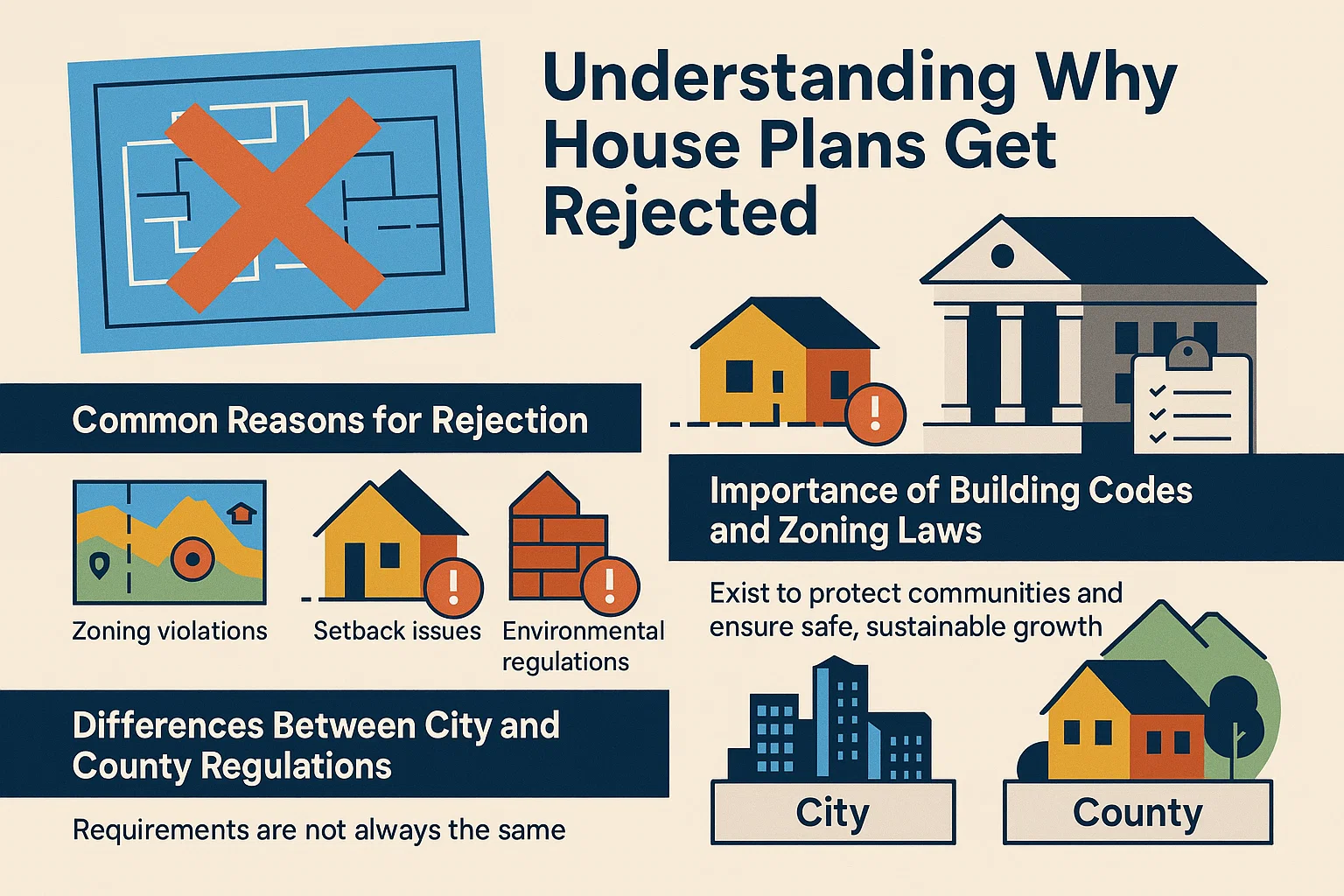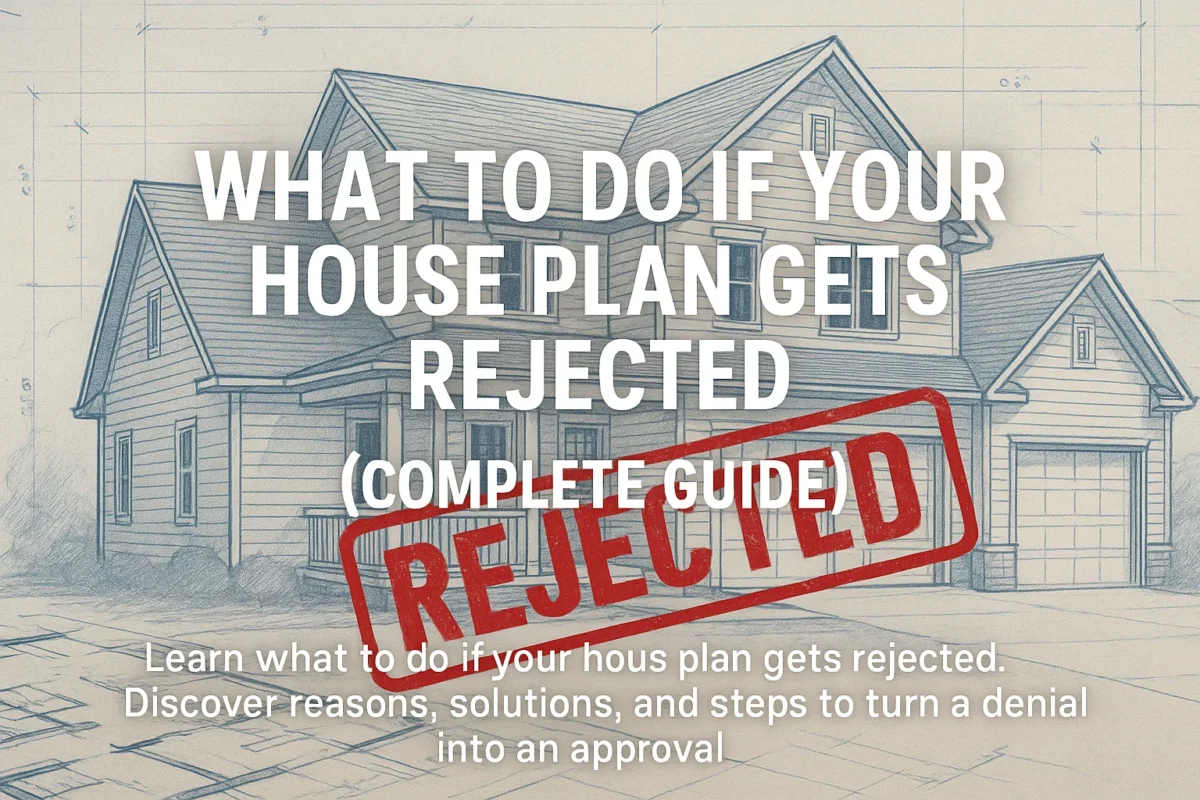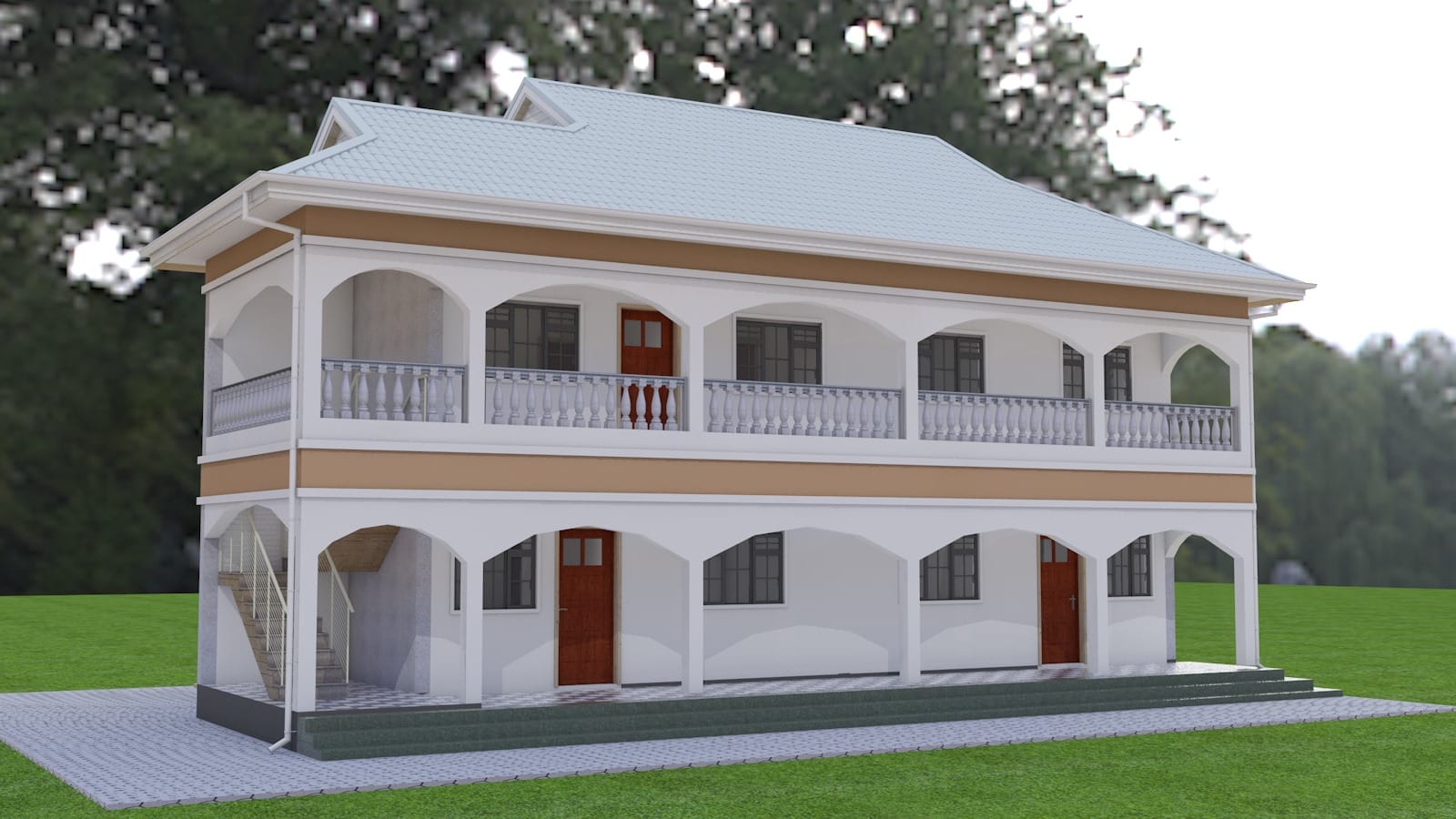Construction, Real Estate
What to Do if Your House Plan Gets Rejected (Complete Guide)
What to Do if Your House Plan Gets Rejected is a question that many homeowners face when they start the journey of building their dream house. The planning and approval process can feel overwhelming, and when you finally submit your carefully designed house plan, the last thing you want is to receive a notice of rejection. Yet this is a reality for thousands of applicants every year. Local building authorities have strict rules to ensure safety, compliance, and community standards, and even the most beautifully designed plans can be turned away if they do not meet these requirements.
At first, rejection can feel discouraging, but it is important to remember that this step does not mean your project is over. In fact, most rejections are not permanent denials. Instead, they provide detailed feedback on what needs to be changed so that your plan can eventually be approved. By carefully reviewing the reasons behind the rejection, working closely with architects or engineers, and communicating with planning officials, you can address the issues and move forward with confidence.
This guide will walk you through the most common reasons house plans are rejected, the immediate actions you should take when it happens, and the strategies to prevent rejection in the future. Whether you are preparing to build your first home or managing a large construction project, knowing how to respond to a rejected plan will save you time, reduce stress, and keep your dream home within reach.
Understanding Why House Plans Get Rejected
When a house plan is rejected, it is rarely because the design is unattractive or poorly thought out. Most rejections happen because the plan does not comply with local laws, zoning regulations, or safety codes that protect both the homeowner and the community. Understanding these reasons is the first step in turning a setback into an opportunity for improvement.

Common reasons for rejection
One of the most common reasons is zoning violations. Every city or town has zoning rules that decide how land can be used. If your house design does not fit the type of construction allowed in that area, the plan will likely be rejected. Another frequent cause is setback issues, which occur when the design places the building too close to the property boundary, road, or neighboring structures.
Structural safety concerns also play a major role. If the foundation, walls, or roof design does not meet stability and strength standards, officials cannot approve the plan because it might put future occupants at risk. Fire safety is another critical factor. Plans without proper fire exits, window sizes for escape, or fire-resistant materials can be denied immediately.
Environmental rules are equally important. If the house design threatens protected trees, wetlands, or other sensitive land, approval will not be given until changes are made. In recent years, energy efficiency standards have also become a significant reason for rejection. Homes that fail to include proper insulation, ventilation, or water-saving systems often face delays in approval.
Importance of building codes and zoning laws
Building codes and zoning laws exist to protect communities and ensure safe, sustainable growth. While they might feel restrictive, they are designed to create neighborhoods where people can live safely and comfortably. Building codes regulate essential elements like structural strength, fire safety, plumbing, and electrical systems. Zoning laws, on the other hand, determine how tall your house can be, how far it must be set back from the road, and even what style or appearance may be acceptable in certain districts.
Ignoring these rules almost always results in rejection. Even a minor mistake, such as placing windows too close to a neighbor’s property or failing to include an accessible entryway, can prevent approval. By learning about these codes before submitting your plan, you can reduce the chance of rejection and save valuable time.
Differences between city and county regulations
It is also important to note that city and county requirements are not always the same. Urban areas usually enforce stricter guidelines to manage dense populations, traffic, and safety risks. For example, a house plan that meets county rules for a rural property may be rejected within city limits because of tighter restrictions on height, setbacks, or appearance.
Rural counties may allow more flexibility in design but may still have environmental or energy efficiency rules that need to be followed. This difference is why homeowners should always confirm which authority governs their property before submitting a plan. Consulting both city and county offices early can prevent surprises later.
First Steps After Your House Plan is Rejected
Receiving a rejection letter for your house plan can feel like a major setback, but it is important to remember that rejection does not mean the end of your project. In most cases, it simply signals that adjustments are needed before approval can be granted. The way you respond in the first few days after receiving the notice can make the difference between a smooth path forward and a long period of delays.
Carefully reading the rejection notice
The very first step is to read the rejection notice in full. Many homeowners skim through the document and miss important details that explain exactly why the plan was denied. Every rejection letter contains specific feedback from the planning department, whether it relates to zoning, structural issues, or environmental concerns. Taking the time to study this feedback gives you a clear picture of what needs to be addressed. Highlighting or making notes on the problem areas will help you prepare questions for your next meeting with officials or your architect.
Contacting the planning department
Once you understand the feedback, the next move is to contact the planning department directly. A phone call or face-to-face meeting can clear up confusion and provide insight that is not obvious from the rejection notice alone. Planning officers deal with hundreds of applications and can often suggest the simplest path to compliance. Approaching them respectfully and asking specific questions shows that you are serious about correcting the issues. It also opens the door for guidance that can save you from repeated rejections in the future.
Taking notes on required revisions
After your conversation with the planning department, create a checklist of the revisions that need to be made. Break it down into categories such as zoning adjustments, structural changes, or environmental requirements. This organized approach ensures that nothing is overlooked when you work with your architect or builder. Keeping a written record of your notes and the feedback you receive also makes it easier to track progress as you revise and resubmit the plan.
Managing emotions and expectations
It is natural to feel disappointed when a plan is rejected, especially after investing time and money into the design. However, it is important to stay calm and view the rejection as part of the normal approval process. Most projects require at least one round of revisions before gaining approval. By managing your expectations and approaching the process with patience, you will be better prepared to make the necessary adjustments without unnecessary stress.
Reviewing Compliance with Local Building Codes
Once you understand the reasons for rejection and have spoken with the planning department, the next step is to carefully review how your house plan aligns with local building codes. These codes are not arbitrary rules but carefully designed standards that ensure homes are safe, sustainable, and suitable for their communities. Failing to meet even one requirement can result in rejection, so it is essential to examine your plan in detail.
Zoning restrictions and setbacks
One of the most common compliance issues involves zoning rules and setback requirements. Zoning restrictions determine how land can be used, the type of structures allowed, and the maximum building size for a lot. For example, a plot of land may be zoned for single-family residential use, but if your plan includes features that resemble a multi-unit structure, approval may be denied.
Setbacks are another area where plans frequently fall short. A setback is the minimum distance that a structure must be placed from the property boundary, roadway, or neighboring buildings. These distances are designed to protect privacy, allow for utilities, and provide space for emergency access. Even if your plan only exceeds the setback limit by a small amount, it can still result in rejection. Making adjustments to the layout of the home or repositioning it on the lot is often enough to resolve this issue.
Fire safety, ventilation, and structural requirements
Building codes also focus heavily on safety features that protect occupants during emergencies. Fire safety requirements may include installing proper exits, designing hallways wide enough for evacuation, or using fire-resistant building materials. Windows must often meet size standards to ensure they can function as emergency escape points.
Ventilation is another area of concern. Authorities want to make sure that living spaces receive adequate airflow to prevent issues with air quality and mold growth. If your plan does not provide enough ventilation through windows, vents, or HVAC systems, revisions will be required.
Structural requirements cover the strength and stability of the building itself. Engineers and inspectors look at whether the foundation can handle the soil type, whether the walls and roof are strong enough to withstand local weather conditions, and whether the overall design meets load-bearing standards. Any weakness in these areas can be grounds for rejection.
Environmental impact and energy efficiency rules
Modern building codes increasingly focus on environmental protection and sustainability. Your house plan may be rejected if it threatens wetlands, protected trees, or sensitive wildlife areas. In some regions, authorities also enforce rules that require homes to manage stormwater runoff properly, which may involve including retention ponds, permeable paving, or drainage systems in the design.
Energy efficiency has also become a major consideration. Many municipalities require homes to meet standards for insulation, energy-efficient windows, and heating or cooling systems that reduce overall energy use. Plans that ignore these requirements may be rejected until changes are made. These rules are not only about protecting the environment but also about ensuring that future homeowners enjoy lower utility bills and healthier living conditions.
Working with Architects and Engineers
Why professional support is crucial
House plan rejection often comes down to technical gaps, sometimes as small as a missed setback measurement or as major as an under designed structural element. This is where architects and engineers become essential. Architects bring creative design while ensuring that the layout meets zoning rules, space efficiency, and safety standards. Engineers focus on the technical backbone of the project, checking structural strength, proper load distribution, and compliance with environmental and safety requirements. Together, they transform your dream home into a design that is both inspiring and legally sound.
How to revise plans effectively
Revisions do not always require starting from the beginning. Skilled professionals can make precise adjustments that satisfy inspectors without removing the original vision of your home. For example, moving a wall slightly, adjusting the roof pitch, or reworking drainage can solve major objections. When architects and engineers work together, they preserve your design intent while ensuring that every requirement is met.
Cost considerations when making changes
Revisions will involve an extra cost, but this is far more affordable than the expense of repeated rejections, delayed construction, or legal disputes. Professional guidance from the beginning saves both time and money. It should be seen as an investment in smoother approvals and quicker project timelines.
How Nyolenju Structures Can Help
At Nyolenju Structures, we focus on connecting homeowners, architects, and engineers in a way that simplifies the entire process.
Collaboration with architects: We help maintain your design vision while ensuring full alignment with building codes and zoning laws.
Engineering support: Our team checks the structural details, including foundation stability and roof design, to guarantee safety and durability.
Plan review and compliance checks: We carefully review plans before submission to identify and correct issues that might cause rejection.
Efficient revisions: If your plan is rejected, we coordinate with your architect and engineer to make only the necessary changes, saving you both time and resources.
Client advocacy: We engage directly with planning authorities when needed, providing clear explanations and presenting solutions in a professional manner.
Nyolenju Structures acts as your project partner, making sure that your design not only reflects your dream but also gains approval in the real world.
Appealing the Decision
Why an appeal might be necessary
Even after careful revisions with the help of architects and engineers, there are times when a planning authority may still reject your house plan. This does not always mean your project is over. In many cases, you have the right to appeal the decision and present additional evidence or professional opinions that support your case. An appeal gives you a second chance to demonstrate that your design is safe, compliant, and appropriate for your property.
When and how to file an appeal
Most municipalities allow homeowners a limited window to challenge a rejection. This period is usually between thirty and sixty days, depending on local regulations. Filing an appeal requires submitting a written request to the planning office, along with any supporting documents. Acting quickly is important because missing the deadline may mean restarting the entire approval process.
Gathering supporting documents and evidence
A successful appeal depends on strong documentation. This may include updated site surveys, soil tests, engineering reports, or letters from licensed professionals. Sometimes even small clarifications, such as corrected measurements or additional safety details, can convince the review board to reconsider your plan. The more clear and well presented your documents are, the stronger your case will be.
Working with professionals during an appeal
An appeal is often more persuasive when guided by experts. Architects can refine the visual presentation of your plan while engineers can provide technical reports that address safety and structural concerns. Planning consultants and legal experts can also play a key role, especially when the rejection is based on zoning interpretations or complex legal rules. Their involvement can help translate technical details into language that decision makers understand.
Costs and timelines to expect
Appeals can take anywhere from one to three months depending on the municipality. While there are costs involved in preparing new documents and hiring experts, these are often minor compared to the potential expense of starting the entire project over. By investing in a well managed appeal, you safeguard your project and move closer to getting your dream home approved.
Preventing Rejection in the Future
Why prevention matters
Although rejection is a common part of the building process, preventing it wherever possible saves time, money, and emotional stress. The more proactive you are before submitting your plan, the higher the chance of first time approval. Prevention is about being thorough, well prepared, and supported by the right professionals.
Pre submission consultations with authorities
One of the most effective ways to prevent rejection is to meet with the local planning department before submitting your house plan. These early consultations give you a chance to ask questions and receive feedback on potential issues. For example, an officer may point out height restrictions, setback rules, or environmental considerations that need to be factored into your design. By identifying these early, you can avoid costly revisions later.
Conducting feasibility studies
A feasibility study evaluates whether your chosen design is realistic for your specific property. This includes checking soil conditions, utility access, road connections, and zoning classifications. Without a study, you might design a home that looks perfect but cannot legally or safely be built on your land. Feasibility studies give you confidence that your design will meet both technical and legal requirements from the start.
Using pre approved house plans
Some municipalities provide a list of house plans that have already been reviewed and approved for compliance with local regulations. Using one of these plans can significantly speed up the approval process. Even if you prefer a custom design, starting with a pre approved base plan and making small adjustments can reduce the risk of rejection.
Regular plan reviews by professionals
Prevention also involves professional oversight. Architects can confirm that your design meets zoning and safety rules, while engineers check for structural soundness. These reviews act as a safety net, ensuring that no detail is overlooked. A small adjustment at this stage can prevent a complete rejection later.
How Nyolenju Structures supports prevention
At Nyolenju Structures, we believe that the best way to handle rejection is to avoid it altogether. Our team assists homeowners by carrying out detailed compliance checks before submission, conducting site evaluations, and collaborating with local planning departments. We also guide clients through feasibility studies and help adapt designs to match both personal preferences and regulatory requirements. By combining technical expertise with practical experience, we make sure your plan is built on a strong foundation of compliance and readiness.
Long term benefits of prevention
Taking preventive steps does more than secure approval. It shortens construction timelines, reduces unexpected expenses, and gives you peace of mind. With fewer revisions and delays, you can move into your dream home faster and with greater confidence that it has been designed and approved correctly.
FAQs on What to Do if Your House Plan Gets Rejected
1. Can I resubmit my house plan after rejection?
Yes. Most planning departments encourage revisions and resubmission.
2. How long does the appeal process take?
It varies but typically takes 30–90 days.
3. Do I need a lawyer to appeal?
Not always. But if legal issues arise, a lawyer or planning consultant can help.
4. Can I use the same plan for a different city or county?
Possibly, but codes differ. Always review the new area’s rules.
5. How much do revisions usually cost?
Minor changes may cost a few hundred dollars, while major redesigns can run into thousands.
6. Is rejection common?
Yes. many first-time plans face rejection. It’s a normal part of the process.
Conclusion: Turning Rejection into a Successful Approval
A rejected house plan may feel like the end of a dream, but in reality it is simply part of the journey toward building a safe, compliant, and lasting home. Rejection highlights what needs to be improved, giving you the opportunity to refine your design and strengthen your project.
By understanding why plans are rejected, reviewing compliance with local codes, and working closely with architects and engineers, you transform setbacks into stepping stones. If rejection still occurs, an appeal offers a second chance to present your case with stronger evidence and expert support. And by focusing on prevention through consultations, feasibility studies, and professional reviews, you greatly increase the chances of gaining approval the first time.
At Nyolenju Structures, we stand with homeowners at every stage of this journey. We help interpret rejection notices, coordinate revisions with architects and engineers, and prepare detailed documentation for appeals. We also guide clients through preventive steps, such as compliance checks and feasibility studies, so that problems are solved before they ever reach the planning desk. Our role is not only technical but also supportive, ensuring you feel confident and well represented throughout the process.
Every rejection is an opportunity to build better, and with the right guidance, approval is always within reach. Nyolenju Structures is committed to turning obstacles into progress and helping you move from rejected plans to an approved design that reflects your vision. With us as your trusted partner, your dream home does not just remain an idea on paper. It becomes a reality built on a foundation of compliance, safety, and peace of mind. Call or WhatsApp Us today for a discussion.



